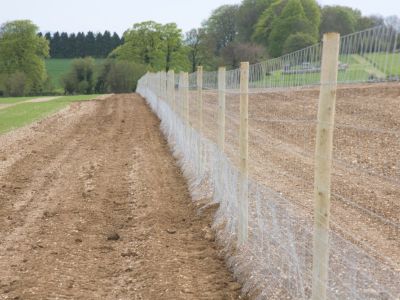The Rules on Deer Fences
Deer are elegant and graceful creatures, but these attributes fall short when they have been in the garden eating your prize plants. Look on the internet and deer fencing designs abound, but many of the ideas are expensive, ugly, or take special skills to erect. Attractive deer proof fencing takes a lot of materials and contractor know how. Single strand electric fences or simple deer mesh are fairly easy control options. Multiple line electric fences and 8 to 10 foot (2-3 m.) tall wooden deer proof garden fences are better options for high populations but more time consuming and costly. Learn how to build a deer proof fence that works and doesn’t break the bank. Deer can jump quite high and are able to leap over many obstacles to get to a food source. They don’t obey signs and they are usually not repelled by common remedies such as human hair or chemical deterrents. Any structured fencing needs to be at least 8 feet (2 m.) high, as this is the distance a white-tailed deer can jump. Wire lines and deer netting can be lower, but netting should be tilted to prevent the animal from barreling through the material. Their first impulse is to go around or under an obstacle but need drives their response to different deer fencing designs. Before you commit to building a deer proof fence, observe the animal’s behavior to see if they are jumpers or sneak around items. This will help you decide if electric, netting, or permanent wood or wire is the best way to keep out the animals.
Basic Deer Fencing Designs
Single strand electric fences are simple to erect. Once you have the wire installed, run it to posts set into concrete at intervals of about 5 feet (1.5 m.). Single strand electric is useful when deer populations are low. Run the strand 30 inches (76 cm.) off the ground and mark the fence at intervals with bright tape. You can in doctrine the animals by smearing peanut butter on aluminum on the fence. The animal will be stung and, hopefully, learn to stay away. One of the more common deer fencing designs is to use deer netting. Use streamers to warn deer of the presence of the fence and keep them from running through. Wire fencing is also an option and should be installed on sturdy metal posts and at a height that will prevent jumping.
How to Build a Deer Proof Fence That Lasts
Attractive deer proof fencing takes a bit more time and money than wire, netting, or a single strand electric fence. For high populations of deer, use multiple electric wires at 10, 20, and 30 inches (25, 50, and 76 cm.) from the ground. If your deer are especially sneaky, use two electric fences. The inner fence should be set at 50 inches (127 cm.) from the ground and an outer perimeter 38 inches (97 cm.) from the inner set at 15 and 43 inches (38 and 109 cm.). A lovely wood fence is a big commitment and can be costly. These need to be at least 8 feet (2 m.) high. If there is already a standard 6 to 8 foot (2 m.) fence, install additions to posts and string wire across the top to prevent jumping. Make sure a wooden fence is tight and doesn’t allow the deer to see the other side. Sometimes this is as much a deterrent as the fence since they don’t know what goodies might be on the other side.
